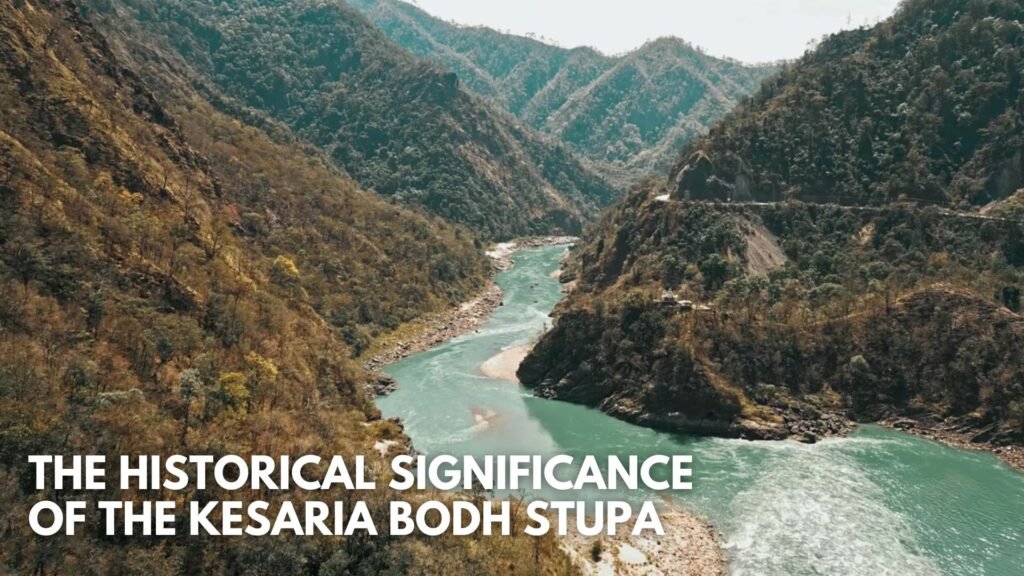One of the most important Buddhist monuments is the Kesaria Bodh Stupa, which is thought to be the highest stupa in the world and is situated in the East Champaran region of Bihar, India. It has great historical and theological significance for Buddhists and dates back to the Mauryan and Gupta eras.
According to legend, the stupa marks the location where Lord Buddha gave one of his final teachings to his students during his last voyage, and as a sign of his departure, gave them his begging bowl. Standing at a height of about 104 feet, the building combines spiritual symbolism with historic architectural genius.
Stories from the life of Buddha are told on the enormous circular terraces of Kesaria Bodh Stupa, which are embellished with elaborate carvings and pieces of Buddhist sculpture. In spite of The landmark, which is mostly ruins, is a testament to India’s long Buddhist history and draws pilgrims, historians, and archaeologists. Encapsulating ageless grandeur and spirituality, it stands as a tranquil emblem of serenity and enlightenment within beautiful environs.
Table of Contents
Introduction
Hidden in the heart of Bihar, India, is the Kesaria Bodh Stupa, a majestic icon of Buddhist tradition and the world’s largest Buddhist stupa. This historic architectural marvel, rich in history and spiritual importance, has captivated historians, tourists, and devotees alike. But what makes Kesaria Stupa so unique? Let’s look at its rich history, architectural splendor, and why it belongs on every traveler’s bucket list.
The historical significance of the Kesaria Bodh Stupa
The Stupa’s Connection to the Lord Buddha
Kesaria Stupa is thought to have been built to commemorate the location where Lord Buddha delivered his final discourse before achieving Mahaparinirvana. According to Buddhist traditions, Buddha left his alms bowl here to mark the completion of his voyage. This makes the site deeply revered among Buddhists worldwide.

Discovery and Archaeological Importance
This historical gem was rediscovered by the Archaeological Survey of India (ASI) in 1958. Excavations revealed several layers of construction, with artifacts dating back to the 3rd century BCE, during the Maurya and Gupta periods.
Location and Accessibility
Where is the Kesaria Bodh Stupa located?
Kesaria Bodh Stupa is located in the East Champaran district of Bihar, India. It is located roughly 110 kilometers from Patna, the state capital, and 35 kilometers from Vaishali, another famous Buddhist site.
How to Get to Kesari Stupa
By Air: Patna Airport (Jay Prakash Narayan International Airport) is approximately 110 kilometers away.
By Train: The nearest railway station is Motihari, which is approximately 40 kilometers from Kesaria.
By Road: Kesaria is well connected by road. You can take taxis or buses from Patna or Motihari.
Architectural Brilliance of the Kesaria Bodh Stupa
The largest Buddhist stupa in the world.
Kesaria Stupa stands 104 feet tall, surpassing even Indonesia’s famous Borobudur Stupa. Originally, it was considerably taller, but natural erosion and time have diminished its height.

Layers and Design Structures
The stupa is made up of six circular terraces decorated with elaborate carvings of Buddha figures, stupas, and floral patterns. The highest level contains a big dome that represents enlightenment.
Cultural and Religious Importance
Buddhist pilgrimage site.
Kesaria attracts Buddhist pilgrims from all over the world, particularly from Sri Lanka, Japan, Thailand, and Tibet, who come to meditate and find spiritual peace.
Influence on Buddhist Architecture.
Kesaria’s distinctive multi-tiered stupas impacted many subsequent stupas, particularly those in Sri Lanka and Myanmar.
Conservation initiatives
The ASI is attempting to conserve and restore the stupa, keeping it safe from erosion and encroachment.
The best time to visit Kesaria Bodh Stupa.
Ideal weather conditions.
Best months to visit: October through March (cool and nice weather).
Avoid the summer months (April-June) owing to excessive heat.
Special Festivals and Events
Visiting during Buddha Purnima is highly advised, as Buddhist monks perform prayers and special ceremonies.
Nearby Attractions & Places to Explore
Vaishali: A historic Buddhist and Jain pilgrimage place.
Nalanda and Rajgir: Ancient Universities and Buddhist Centers
Local Culture and Cuisine
Try classic Bihari cuisine such as Litti Chokha, Sattu Paratha, and Thekua.
Travel Tips for Visitors
Visitors can enter for free.
While exploring, make sure to bring drink and sunscreen.
Avoid visiting during the monsoon. The paths can be slick.
Photography and scenic views.
The panoramic views from the upper terraces make for breathtaking sunrise and sunset photographs.
Comparison to Other Buddhist Stupas Around the World
Sanchi Stupa: Older yet smaller in size.
Borobudur Stupa is larger but not as ancient as Kesaria.
Why Does Kesaria Stupa Deserve Global Recognition?
Despite its historical and architectural significance, Kesaria is largely underappreciated internationally. More worldwide prominence can help with preservation and tourism.
Conclusion
Kesaria Bodh Stupa is more than just an ancient ruin; it exemplifies India’s rich Buddhist legacy. Kesaria is a must-see for history buffs, spiritual seekers, and those hunting for hidden jewels.
Frequently Asked Questions
Q. Is Kesaria Bodh Stupa the largest stupa in the world?
A. Yes, Kesaria Stupa is the largest Buddhist stupa in the world.
Q. What is the entry fee for Kesaria Stupa?
A. There is no entry fee to visit Kesaria Stupa.
Q. Can I visit Kesaria Stupa in monsoon?
A. It’s not advisable due to slippery paths and waterlogging.
Q. What are the best nearby attractions?
A. Vaishali, Nalanda, and Rajgir are must-visit sites.
Q. Why is Kesaria Stupa not well known?
A. Lack of promotion and government focus keeps it underrated.
Pingback: How to Use ChatGPT AI Tool for Digital Marketing Success